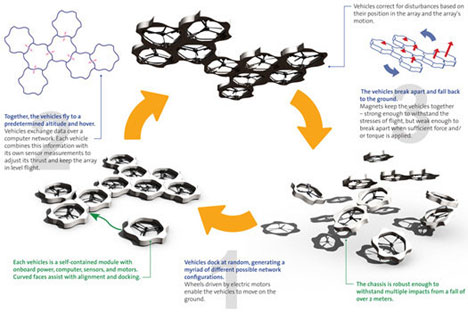
Quadrotors seem to be all the rage in robotics research right now, but even these stable and agile unmanned aerial vehicles (UAVs) have their limitations. That’s why researchers at the Institute of Dynamic Systems and Control at ETH Zurich designed the Distributed Flight Array, a system of small autonomous helicopters that fit together modularly to create a bigger and more powerful aircraft. Every little ‘copter contains its own motor, sensors and control system. Alone, they can only roll along the ground on their little wheels. But they communicate wirelessly with each other and can dock together randomly, making a super ‘copter that can automatically adjust the thrust from each component to keep the entire array level.
The modular approach is great for customizing the machine to the job so that no energy is wasted. Small jobs can use just a few helicopters while jobs requiring heavy lifting can use several helicopters linked up to work together. The autonomous control systems mean that the ‘copters can dock and un-dock on the go, adjusting the flight of the larger machine to keep it stable even while smaller machines are being added or subtracted. This particular project isn’t at the usable stage – the array automatically falls after reaching a certain height – but it’s simple to see how customizable arrays like this could be the future of UAVs. All of which is great and everything, but we’re not looking forward to what happens when these guys gain sentience and start linking up Voltron-style to take over the world.

